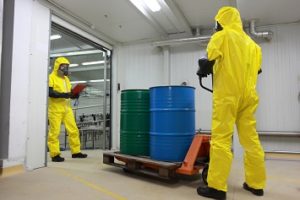If you are a hazardous waste generator, you are more than likely storing waste in containers without a permit pending the waste being shipped off-site. When agency inspectors come around, many go straight to your containers because they are easy to look at and container violations are very common. We’ll take a look at some common hazardous waste container violations and how you can avoid them.

endopack / iStock / Getty Images Plus / Getty Images
Note: Many states’ hazardous waste container requirements are stricter than the federal requirements. Always make sure that you are in tune with your state hazardous waste regulatory requirements.
Problem: Container is not closed. Hazardous waste containers are often left open for entire work shifts. In some cases, they are not properly closed. In other cases, funnels on drums are left open.
Solutions: Stress in your training and facility walkarounds that hazardous waste containers must be closed at all times except when adding or removing waste.
- A properly closed container is where the snap ring is tightly bolted, the bung is screwed in and capped, and the lid is secured.
- Make sure that your employees handling hazardous waste know that an open funnel is an open container. A funnel is considered closed when it screws into the bung and seals with a spring-loaded hinge.
Problem: Containers are in poor condition. Only containers that are in good condition should be used to store hazardous waste.
Solutions: Containers must be inspected at least weekly for leaks or deterioration. Here are three tips to stress with your employees who handle hazardous waste containers:
- Good condition means that there are no severe dents or rust, especially in the seam areas, which could weaken the container and allow it to leak.
- Don’t store containers in a way that will cause them to leak or rupture (e.g., don’t stack containers vertically).
- If you see a waste-filled container that’s not in good condition, transfer the waste to a container that is in good condition.
- Whenever possible, store the waste in the container you plan to ship it in. This could be the container the product came in.
- Keep a log or summary of the weekly inspections. Although generators are not required to do so, it is a good idea. Also, check with your state. Some states explicitly require that hazardous waste generators keep a log or summary of weekly container inspections.
Problem: Improper containers are used. Containers must be suited to the hazardous waste being stored.
Solutions: All employees who handle hazardous waste must be trained on issues pertaining to proper containers, including:
- Certain solvents will dissolve a polyethylene drum and corrosive waste, such as an acid, can structurally weaken a metal drum.
- Make sure that the material that lines the container will not negatively react with the hazardous waste being stored.
- Don’t put different wastes in the same container if they will negatively react with each other.
- Don’t put waste in an unwashed container that previously held a waste that will negatively react with the waste you are currently putting in.
Problem: Containers are not marked properly. There are two issues here. One has to do with marking the accumulation start date and the other with making sure the required information is on the container.
Solutions: Make sure that the container is marked with the date upon which each period of accumulation begins. Make sure that the accumulation date is clearly visible for inspection.
Tips for ensuring the required information is on the container include:
- Remove or spray paint over any old labels on the container.
- Label or clearly mark containers with the words “Hazardous Waste” (and any additional information required by your state).
- Add a clear description of the container’s contents. New federal requirements include that large and small quantity hazardous waste generators mark or label containers with an indication of the hazards of the contents. Examples include:
- The applicable hazardous waste characteristics such as “ignitable,” “corrosive,” reactive,” “toxic”;
- Hazard communication consistent with the Department of Transportation (DOT) labeling or placarding requirements found at 49 CFR 172;
- A hazard statement or pictogram consistent with the Occupational Safety and Health Administration (OSHA) Hazard Communication Standard at 29 CFR 1920.1200; or
- A chemical hazard label consistent with the National Fire Protection Association Code 704.
- Make sure the labels or markings are visible for inspection of each container.
- Put all marks and labels on the same side of the container (away from the bung) for quick identification.
Check tomorrow’s Advisor for some tips on complying with another common hazardous waste container violation: satellite accumulation area rules.
